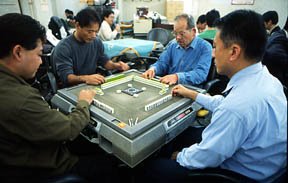This was reported by A.P. today, and I think it shows an interesting cultural struggle going on in Japan today:
From the A.P. wire:
Births in Japan Rise for 7th Month
Japan's birth rate rose for the seventh straight month in August, the government said Friday, raising hopes for an upturn in the country's plunging annual birthrate and declining population.A falling birthrate and an expanding elderly population pose serious concerns for Japan as it struggles to tackle a labor shortage and eroding tax base. Japan's birthrate in 2005 stood at a record low of 1.25 babies per woman in her lifetime, far below the 2.1 rate needed to keep the population steady.
In August, a total of 98,276 births were registered, up 3,001 from the same month in 2005, or a rise of about 3 percent, according to Health Ministry statistics released Friday.
That's the seventh straight monthly gain in birthrates. But Reiji Murayama, an official of the Health Ministry's vital and health statistics division, said it was too early to say that the latest data meant a turnaround in the country's annual birthrate.
"We cannot predict if the falling birthrate may hit the bottom this year yet, until we will see the remaining four months," Murayama said. The nation's population last year declined for the first time on record, shocking officials and spurring a spate of measures to encourage women to have more babies.
To encourage women to have more babies, the government started a project to build more day care centers, while encouraging men to take paternity leave. Amid changing lifestyles, many single women are delaying or forgoing marriage to pursue careers.
Without the religious influences of some other countries in Asia, it isn't surprising that some Japanese women finally said to themselves "I am independently successful, so why should I give up this salary and this freedom just to get married and make babies?" The biggest pressure was probably from the young women's parents, especially if she still lived at home. (It is common for young people to live at home until they are married, but now that the average age for marriage is getting later and later, some of those "young people" are still at home, even into their 30s and later.)
Another barrier to marriage and motherhood was the snail-like pace Japanese bureaucrats and business-leaders take in making changes to meet the modern times. Things like child-care, guaranteed employment after maternity leave, paternity leave, and other benefits to having children are all new concepts in Japan, which the rest of the first world has been toting mother's rights for decades. It took something as drastic as an actual population drop and the rapid increase in the elderly population (leading to the eventual devastating drain on the country's heath care and other resources).How could the government and corporate leaders let things get so bad? Faithful readers to Japan Communications may have a couple guesses.
1) Change is something that is generally avoided and is considered "bad". It's only when not changing becomes more damaging than changing that the push for real change actually happens.
Ten years ago schools started shutting down and there was a hiring freeze on new teachers in some prefectures (this still continues). In many parts of Japan students go to schools where entire floors are left unused. Schools are being converted into community centers, or are rented out. Many young kids now haven't had a teacher under the age of 35. This wasn't enough of a sign to government officials that there was a shift in the national thinking, and a reaction would be needed.
2) The older generation (bureaucrats and company officials) tend to take advice from other members of the older generation, and not from younger or non-Japanese sources.
Three of the big-five auto manufacturers in Japan have hired non-Japanese CEOs in the past five years. Why? Because Japanese CEOs don't work quickly to make drastic changes, but these companies (Mitsubishi, Nissan and one other) were experience losses, and their boards of directors had the intelligence to find quick-minded solution oriented leadership.
Naturally there are more complicated issues going, and a few paragraphs exploring Japanese culture won't solve Japan's population problems, but it is interesting to see how the cultural traits we have looked at can sometimes have farther reaching influences than one might expect.




